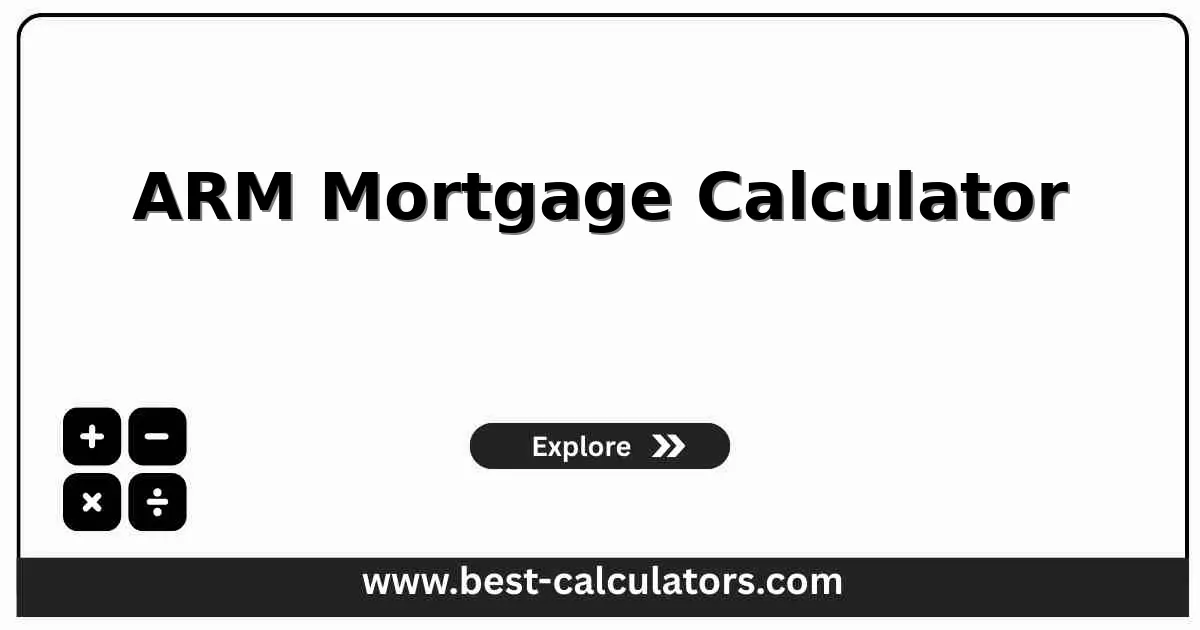ARM Mortgage Calculator - Adjustable Rate Mortgage
Free ARM calculator to determine adjustable rate mortgage payments with rate adjustments, caps, and maximum payment scenarios
ARM Mortgage Calculator
Results
What is an ARM Mortgage Calculator?
An ARM mortgage calculator (Adjustable Rate Mortgage calculator) is a financial tool that calculates mortgage payments for loans with interest rates that change over time. ARMs typically offer lower initial rates than fixed mortgages, then adjust periodically based on market indexes, potentially increasing or decreasing monthly payments throughout the loan term.
This calculator helps with:
- Initial payment calculation - Determine starting monthly payment amounts
- Adjusted payment projection - Estimate payments after rate adjustments
- Maximum payment scenarios - Calculate worst-case payment with lifetime caps
- Risk assessment - Understand payment variability and budget risk
- ARM vs fixed comparison - Compare ARM savings against fixed-rate stability
For standard mortgage payment analysis, use our mortgage calculator to evaluate fixed-rate loans with PITI calculations.
When considering refinancing from ARM to fixed, explore our refinance calculator to determine if switching saves money.
To understand interest rate impacts, our interest rate calculator helps evaluate rate changes on payment amounts.
How ARM Mortgages Work
ARM mortgages have two distinct periods with different rate structures:
Adjusted Rate = Index + Margin (capped by limits)
Maximum Rate = Initial Rate + Lifetime Cap
ARM Structure (e.g., 5/1 ARM):
- First number (5) = Fixed-rate period in years
- Second number (1) = Adjustment frequency (annually)
- Rate Caps = Limits on rate increases per period and lifetime
Example: $300,000 5/1 ARM at 3.5% initial rate. Initial payment = $1,347. After 5 years, rate adjusts to 5.5%. New payment = $1,703 (26% increase). With 5% lifetime cap, maximum rate = 8.5%, maximum payment = $2,307.
Rate caps protect borrowers from extreme increases. Common cap structure: 2/2/5 means 2% maximum increase at first adjustment, 2% maximum per subsequent adjustment, 5% maximum lifetime increase from initial rate.
Key Concepts Explained
Fixed Period
Initial years with locked interest rate. Common periods: 3, 5, 7, or 10 years. Longer fixed periods typically have higher initial rates.
Adjustment Period
Frequency of rate changes after fixed period. Common: annual (1), semi-annual (6 months). More frequent adjustments increase payment uncertainty.
Index & Margin
Index (SOFR, Treasury) fluctuates with markets. Margin (lender's markup) remains constant. New rate = Index + Margin, subject to caps.
Rate Caps
Initial adjustment cap, periodic adjustment cap, and lifetime cap limit rate increases. Protect borrowers from payment shock and extreme costs.
How to Use This Calculator
Enter Loan Details
Input loan amount, initial rate, and loan term from lender quote (e.g., $300K, 3.5%, 30 years)
Specify ARM Terms
Enter fixed period (e.g., 5 for 5/1 ARM) and lifetime rate cap from loan documents
Estimate Adjusted Rate
Project expected rate after adjustment based on current market trends or conservative assumptions
Review Payment Scenarios
Analyze initial, adjusted, and maximum payment amounts for budget planning
Assess Affordability
Ensure you can afford maximum payment scenario before committing to ARM
Compare Options
Compare ARM savings against fixed-rate mortgage stability for your situation
Benefits of Using ARM Calculator
- • Payment Projection: Understand how monthly payments change over time with rate adjustments, enabling realistic long-term budget planning.
- • Risk Assessment: Calculate maximum payment scenarios to ensure affordability even in worst-case rate increase situations.
- • Savings Calculation: Compare initial ARM savings against fixed-rate mortgages to determine if lower initial payments justify future uncertainty.
- • Informed Decisions: Make data-driven mortgage choices understanding both benefits and risks of adjustable-rate financing.
- • Refinance Planning: Identify optimal timing to refinance from ARM to fixed-rate before significant rate increases occur.
- • Strategy Evaluation: Determine if ARM makes sense for short-term homeownership or if fixed-rate better suits long-term plans.
Factors Affecting ARM Payments
1. Market Interest Rates
Rising rates increase adjusted payments and total costs. Falling rates decrease payments. ARM payments correlate directly with broader rate environment.
2. Rate Cap Structure
Lower lifetime caps (2-3%) provide more protection. Higher caps (5-6%) allow larger payment increases but may offer better initial rates.
3. Fixed Period Length
Longer fixed periods (7/1, 10/1 ARM) provide more payment stability but typically have higher initial rates than shorter periods (3/1, 5/1).
4. Index Volatility
More volatile indexes (SOFR) create greater payment uncertainty. Stable indexes provide more predictable adjusted rates.
5. Homeownership Timeline
ARMs benefit short-term owners (3-7 years) who sell before adjustments. Long-term owners face more adjustment risk and potential cost increases.

Frequently Asked Questions (FAQ)
Q: What is an ARM mortgage?
A: ARM (Adjustable Rate Mortgage) has interest rate that changes periodically. Starts with lower rates than fixed mortgages, then adjusts after initial fixed period.
Q: How does an ARM rate adjustment work?
A: Rates adjust based on index (SOFR/Treasury) plus lender margin. Rate caps limit increase amounts per adjustment and over loan lifetime.
Q: What is a 5/1 ARM?
A: Fixed rate for 5 years, then adjusts annually. First number = fixed period, second = adjustment frequency (1 = yearly).
Q: Is an ARM better than a fixed-rate mortgage?
A: Better for short-term ownership (sell before adjustments) or if expecting rate decreases. Fixed better for long-term homeownership and payment predictability.
Q: What are ARM rate caps?
A: Three caps: initial adjustment (first change), subsequent adjustment (ongoing), lifetime (maximum over loan). Common: 2/2/5 structure.
Q: When should I refinance my ARM?
A: Before rate adjustment period begins or when fixed-rate mortgages offer favorable terms. Monitor rates 6-12 months before adjustment.